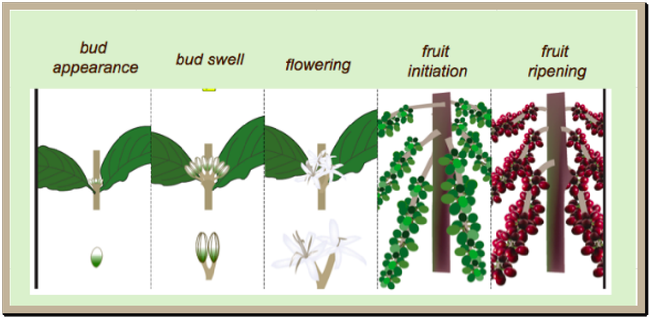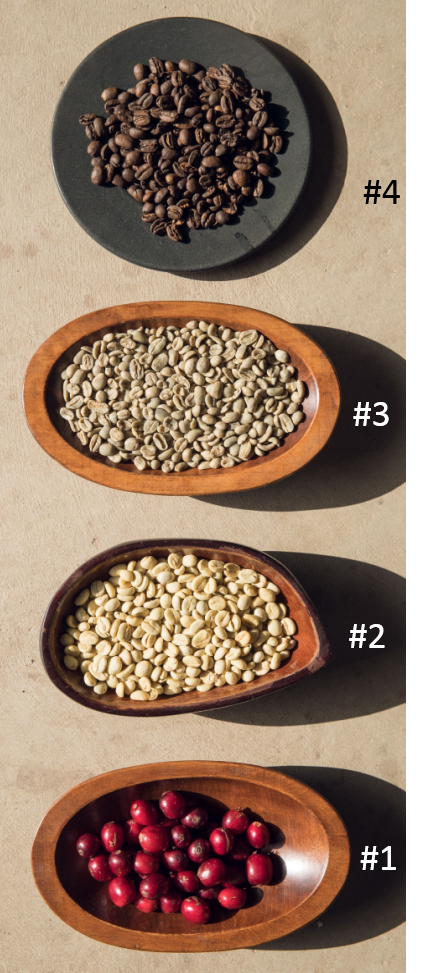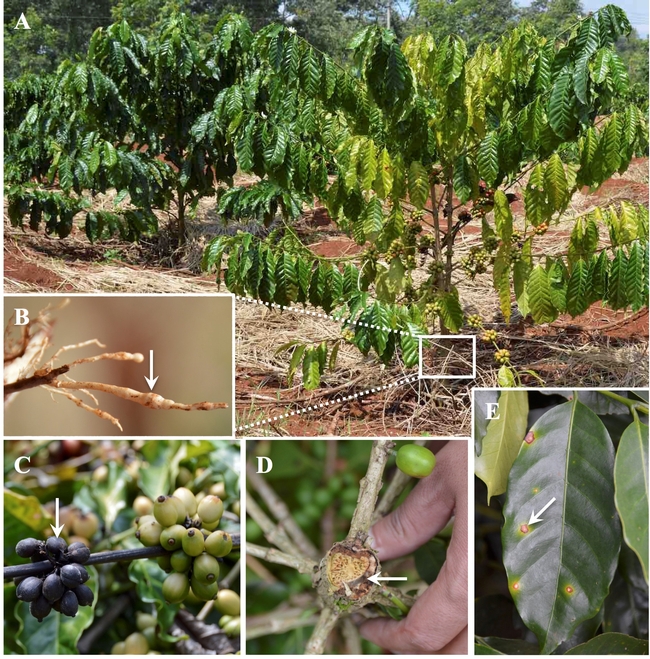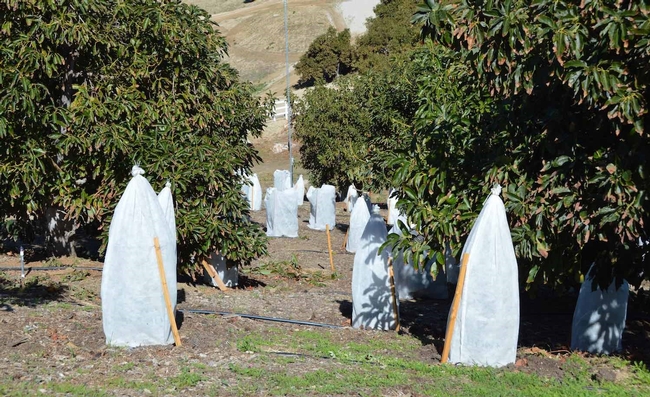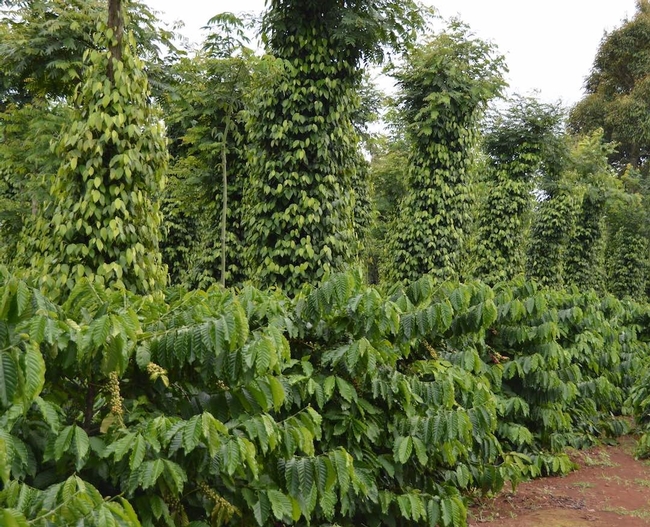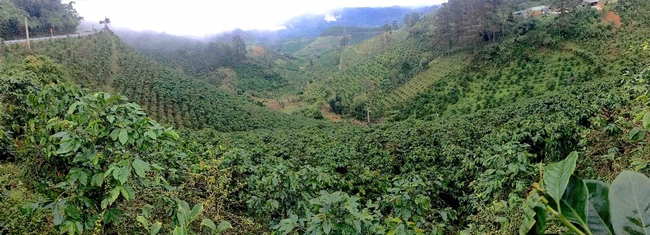Coffee is one of the top 3 most traded commodities in the world. About 12 billion pounds of coffee are consumed each year worldwide. In the US, coffee consumption has been steadily increasing and today Americans average about 4 cups of coffee per day. The US coffee market is worth over $75 billion with 34,000 shops generating $21 billion in retail revenue. The average American consumer is becoming increasingly educated about coffee and many have become connoisseur. Producing dry coffee beans (Fig.1 #4 ) is in many ways similar to wine making because coffee can reflect the character of a variety. After harvest, the berries (a.k.a. cherry; Fig.1 #1) are fermented. During this process yeasts break down the mucilage (i.e., the flesh around the bean). The parchment (Fig.1 #2) that remains around the green beans (Fig.1 #3 ) is subsequently removed by dry milling before roasting. Also just like for wine, coffee aroma profile and organoleptic properties are graded and referred to as a cupping score, which has been developed by the Specialty Coffee Association, a nonprofit, membership-based organization that represents thousands of coffee professionals (https://sca.coffee).
|
Figure 1 - Coffee flower and fruit stages ( # 1 - #4) |
|
Figure 2 - Major diseases encountered in Vietnam coffee production. A-B: Root-Knot nematode. C: Colletotrichum. D: Insect borer. E: Rust |
Coffee (Rubiaceae family) is concentrated in the tropics and subtropics. The genus Coffea has over 60 species of which C. canephora (a.k.a. Robusta) and C. Arabica are the most common ones. Arabica coffee is praised for its excellent cupping quality and consumers demand is high. The US coffee market is dominantly Arabica and imports mainly from Brazil but other importing markets include Asia. I had the privilege to be invited by Dr. Dzung Anh Nguyen at Tay Nguyen University in Dak Lak province, Central highland region of Vietnam, to educate myself about the art of growing coffee and its challenges. Vietnam produces 3 billion lbs of coffee beans annually on 1.5 million acres (95% Robusta and 5% Arabica) and exports about 0.4 billion lbs of coffee to the US, although its main market streams are Europe, Japan and Korea. This industry is valued at $4 billions, with over $3 billions to export. In Vietnam, Arabica yields about 1-2 tons per Ha at $4,000 per ton, whereas Robusta yield twice as much for half the price. France introduced coffee production in Vietnam around 1915. The culture of coffee is now anchored deep in this region and a corner stone of the local economy. The elevation of the central highland in Vietnam ranges from 1500 to 6,000 feet. Above 3000 feet, Arabica is grown and Robusta below that line. The acidic soil, rain pattern and high elevation provide a unique environment for Arabica coffee plants. In addition, high elevation limits the incidence and severity of coffee rust. This fungal disease is a major limiting factor to coffee production worldwide. Robusta is known to be more tolerant to the disease and can be grown at lower elevation where disease pressure is higher. Besides rust, coffee berry borer, nematodes and soil borne fungal pathogens can cause devastating losses in coffee growing regions. Invasive pests and diseases, global warning, water availability and quality are key variables that need to be factored into market projection growth and availability of the supply chain. According to the Australia's Climate Institute's, hotter weather and changes in rainfall patterns are projected to cut the area suitable for coffee in half by 2050.
In the US, Hawaii is the leading coffee producer with 38 million lbs of cherry on 7,000 bearing acres in 2017 (USDA Statistics). As a reference point, a pound of Kona coffee cost about $35-50 at a retail store. In California coffee is not a commodity but a niche market that produces rare and specialty coffee. This is the fastest growing segment of the US coffee market and it has been valued at over $40 billion. In the past decade, California has become a fertile region for coffee. There was currently about 30-farms and 30,000 trees but with projections of 60,000 in this upcoming year. Research led at UC Davis has provided valuable science –based information (including the Arabica genome sequencing) to coffee production under our climate. In collaboration with the UC Cooperative Extension and specifically Mark Gaskell, practical guidelines have been developed to optimize coffee production in our region that includes selection of adapted varieties, plant nutrition and irrigation needs http://ceventura.ucanr.edu/Com_Ag/Subtropical/Minor_Subtropicals/Coffee_/
Evidence suggests that the mesoclimate of southern California (i.e., where avocado is grown) provides enough heat and sunlight units to grow Arabica. California also offers the unique advantage of having no serious pests or diseases. Another major advantage is the use of automated and controlled irrigation because it has favored optimal fruit set and maturation. The only limiting factors can be alkaline soils and cold temperatures both of which can be managed by soil acidification (with sulfur and pit moss applications) and tree protection at the establishment of the orchard. Orchards of inter-planted coffees plants and avocado are common to provide shading. Likewise in the low lands of Vietnam robusta trees were inter-planted with pepper trees. This model also offers an economic advantage to maximize land surface and increasing profit. The California business model developed under the leadership of FRINJ coffee (www.frinjcoffee.com) and Good Land Organics (www.goodlandorganics.com) has boosted the local coffee industry. They have the ambitious goal to make California the world capital of specialty coffee. Adopting a science-guided approach has provided a solid foundation to make coffee farming lucrative. The start up costs for coffee production are the same as for avocado, but can be 3 times more profitable. In the current marketplace, specialty coffee price can range between $60-300 per pound (that's a $8-16 per cup). The quality of FRINJ coffee has received international recognition for its quality (it ranked 27th for best coffee of 2015) and this storyline was highlighted in the New-York Times. (https://www.nytimes.com/2017/05/26/business/your-coffee-is-from-where-california.html).
Figure 3: Coffee farm in the US (top) and Vietnam (bottom). Coffee plants are inter-planted with avocado and pepper trees to provide shade for coffee and optimize land surface.
Attached Images:
